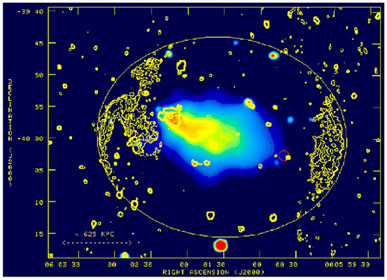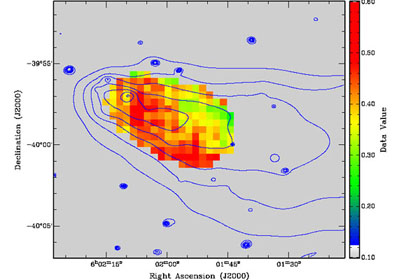


Simulations of the cosmic large-scale structure (LSS) predict that
about 40-50% of baryons at epoch z < 2 could reside in the
Warm-Hot Intergalactic Medium (WHIM) with temperatures 105 -
107 K at moderate overdensities
 ~ 10
(Cen & Ostriker
1999,
Davé et
al. 2001).
The WHIM heating is due to shocks driven by gravitationally accelerated
flows in the LSS structure formation scenario (e.g.
Kang et
al. 2007).
The simulations demonstrate that the X-ray and ultraviolet O VI, O VII
and O VIII lines and the H I
Ly
~ 10
(Cen & Ostriker
1999,
Davé et
al. 2001).
The WHIM heating is due to shocks driven by gravitationally accelerated
flows in the LSS structure formation scenario (e.g.
Kang et
al. 2007).
The simulations demonstrate that the X-ray and ultraviolet O VI, O VII
and O VIII lines and the H I
Ly line traces the
low-density cosmic web
filamentary structures. Intervening metal absorption systems of
highly ionised C, N, O, Ne in the soft X-ray spectra of bright AGN
were suggested to trace the WHIM. The detection of shocked WHIM
requires very sensitive UV and X-ray detectors, both for absorption
and for emission processes (see e.g.
Kaastra et
al. 2008,
Richter et
al. 2008
- Chapters 9 and 3, this volume). Dedicated future missions like the
Cosmic Origin Spectrograph (COS), the X-Ray Evolving
Universe Spectrometer (XEUS), Constellation-X and
the Diffuse Intergalactic Oxygen Surveyor (DIOS) will provide
high resolution spectroscopy of the shocked WHIM. The WHIM ions of
different charge states have highly non-equilibrium (anisotropic)
initial states just behind a collisionless shock that relaxes
to equilibrium states through Coulomb collisions. As was discussed above
a strong collisionless shock could generate a spectrum of
MHD-fluctuations. These MHD-fluctuations can carry a substantial
fraction of the shock ram pressure. The velocity fluctuations will
result in non-thermal
broadening of the lines, potentially important for simulations of
emission/absorption spectra of the WHIM and observational data
analysis. Specific features of collisionless shock heating of the
WHIM ions are discussed in
Bykov et
al. 2008
- Chapter 8, this volume. In this paper we discuss only a few
observations of clusters of galaxies.
line traces the
low-density cosmic web
filamentary structures. Intervening metal absorption systems of
highly ionised C, N, O, Ne in the soft X-ray spectra of bright AGN
were suggested to trace the WHIM. The detection of shocked WHIM
requires very sensitive UV and X-ray detectors, both for absorption
and for emission processes (see e.g.
Kaastra et
al. 2008,
Richter et
al. 2008
- Chapters 9 and 3, this volume). Dedicated future missions like the
Cosmic Origin Spectrograph (COS), the X-Ray Evolving
Universe Spectrometer (XEUS), Constellation-X and
the Diffuse Intergalactic Oxygen Surveyor (DIOS) will provide
high resolution spectroscopy of the shocked WHIM. The WHIM ions of
different charge states have highly non-equilibrium (anisotropic)
initial states just behind a collisionless shock that relaxes
to equilibrium states through Coulomb collisions. As was discussed above
a strong collisionless shock could generate a spectrum of
MHD-fluctuations. These MHD-fluctuations can carry a substantial
fraction of the shock ram pressure. The velocity fluctuations will
result in non-thermal
broadening of the lines, potentially important for simulations of
emission/absorption spectra of the WHIM and observational data
analysis. Specific features of collisionless shock heating of the
WHIM ions are discussed in
Bykov et
al. 2008
- Chapter 8, this volume. In this paper we discuss only a few
observations of clusters of galaxies.
6.1. Evidence for shocks in galaxy clusters
Clusters of galaxies are believed to form within the hierarchical build up of the large scale structure of the Universe. Small objects collapse first and then merge in a complex manner to form larger and larger structures. Therefore, once in a while during their formation, clusters of galaxies undergo so called major merger events. In such events, proto-cluster structures of similar masses (typical ratios 1:10 - 1:1) are colliding with super sonic velocities (typically several 1000 km s-1). These merging events are a source of shocks and turbulence. They redistribute and amplify magnetic fields, and they are a source of acceleration of relativistic particles within the intracluster medium. Additionally, it is expected that the accretion of the diffuse, unprocessed (and therefore relatively cold) matter onto the DM node of the cosmic web creates a virialisation shock (also called accretion shock), which is expected to be located far in the cluster periphery (typically a few Mpc from the cluster centre for massive systems). Some examples of relevant cosmological simulations are presented by Dolag et al. 2008 - Chapter 15, this volume.
X-ray observations, revealing the thermodynamical state of the intracluster medium are therefore the natural means for searching for the signatures of such non thermal phenomena. However, due to biases in the observational processes, caused by the complex temperature structure of the intracluster medium, such signatures are very hard to detect (for a more detailed discussion see Mazzotta et al. (2004) and references therein). Nevertheless, some detections of shocks in galaxy clusters have been revealed by high resolution Chandra and XMM-Newton observations. For a recent review see Markevitch & Vikhlinin (2007). One of the most spectacular examples of a merging galaxy clusters is the case of 1E 0657-56 (Markevitch et al. 2002).
The sensitivities of current X-ray instruments are not sufficient to map the state and structure of the intracluster medium in the periphery of galaxy clusters. However, the discovery of arc like radio emission in the periphery of some clusters (so called radio relics), are thought to trace shocks running through the intracluster medium. Spectacular examples are Abell 3667 (see also Ferrari et al. 2008 - Chapter 6, this volume) or the radio relics in Abell 3376 recently discovered by Bagchi et al. (2006), see Fig. 8. Thereby, such radio observations are currently the only possibility to observe shocks outside the central regions of galaxy clusters. A more detailed discussion of numerical models of such radio relics is provided by Dolag et al. 2008 - Chapter 15, this volume.
 |
Figure 8. Abell 3376 (taken from Bagchi et al. 2006: X-ray emission from XMM-Newton archive data, with VLA 1.4 GHz radio contours superimposed. The ellipse shows an elliptical fit to the peripheral radio structures, and the `+' marks its centre. The circles mark the positions of the two brightest cluster galaxies. |
Shocks are also expected to trigger star formation, as indicated by numerical simulations (e.g. Bekki 1999), which will leave detectable imprints in the intracluster medium even long (several Gyr) after the shock passed through. Multiple supernova explosions in the star forming regions (superbubbles) will additionally produce copious small scale shocks and accelerate non-thermal particles (e.g. Bykov 2001). One of the tracers for these processes can be excess metallicity in the intracluster medium, produced by the enhanced star formation period (e.g. Schindler et al. 2005). Fig. 9 shows the inferred metallicity map for Abell 3376, indicating previous merger activity of the cluster (see Bagchi et al. 2006).
 |
Figure 9. Metallicity map of the intracluster gas in Abell 3376 (taken from Bagchi et al. 2006). |